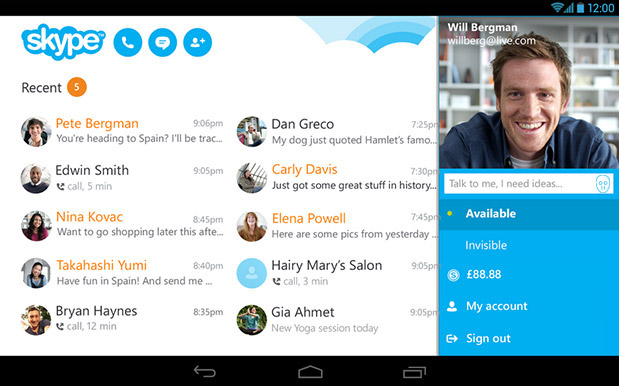
Total Pageviews
Thursday 13 February 2014
Cable companies and tech giants reportedly joining forces to push 'WifiForward'

Samsung Galaxy S4 on Sprint now getting Android 4.4 KitKat

Personal Assistant App EasilyDo Introduces its First Premium Features
EasilyDo, a smartphone app that aims to help users become more productive, is launching version 3.0 today with a number of additions, including its first premium features.
The app basically provides users with a to-do list that allows them to perform basic tasks, such as getting directions to their next meeting or posting birthday messages on Facebook, with minimal effort — usually just a single tap. (It also allows users to build their own automated tasks.)
By paying an additional $4.99 per month or $49.99 per year, users can now get access to more features like improved contact management (with contact details automatically saved from email — co-founder and CEO Mikael Berner predicted that this will be the most popular new feature), real-time travel alerts (for things like gate changes and flight delays), real-time notifications for important emails such as airline boarding passes and restaurant reservations, 10 percent off gift cards purchased in the app, and improved customer support.
“We wanted to make sure we had a good, loyal, regular customer base and that they told us what they wanted,” Berner said. “We didn’t put any premium features in the way of the value for most people.”
He also noted that this is these subscriptions will serve as the company’s second revenue source, after gift card purchases.
And yes, EasilyDo 3.0 includes new features for non-paying users too. The feed of tasks is supposed to be smarter now, for example adding weather alerts in the morning and traffic alerts at the time that you usually leave for the office. You can now set reminders to appear automatically at a certain time. And the premium travel alerts will be available for free for “a short introductory period.”
Looking ahead, Berner suggested that EasilyDo is moving further away from the smart calendar apps that it seemed, to compete with initially, at least in some ways, and is becoming more like a homescreen app — in fact, he suggested that Google Now has done a lot to help acquaint people with the concept.
“We believe we will eventually evolve into an applciation that makes it so that you never have to search again,” he said.
via TechCrunch » Startups http://ift.tt/1bsaxNu
5K Videos And Counting, Curious Lands $15M From GSV To Help Teachers Monetize Bite-Sized Lessons
Thanks to the proliferation of smart devices, cloud-based services and more fluid content creation and distribution systems, technology is fundamentally changing the way we learn. Not only is it easier and cheaper than ever before to find, create and consume learning content, but with better digital video solutions storming into every classroom, learning is actually becoming an enjoyable experience.
While the web is now brimming with video-based learning tools, the majority of today’s popular platforms are focused on academic experiences and use cases, offering digital versions of classes, courses and lectures. Curious launched last summer to give life-long learners, hobbyists and curious minds a video-based platform and marketplace of their own.
With “bite-sized” video lessons from over 700 teachers on topics that range from how to sew and Pilates for beginners to how to use Excel, Curious is looking to be the more targeted, navigable and interactive version of YouTube for continuing education. In the other words — the place you go to peruse and discover how-to content on any subject, via the Web or mobile.
While $7.5 million in backing from Redpoint Ventures and former Apple Chairman Bill Campbell and others at launch certainly helps, if Curious hopes to keep pace with the bigs — and the increasing demands on (and for) video-based learning platforms — speedy scaling is key. The startup has been moving quickly to expand its marketplace, both by building out its lesson library and increasing the depth of its subject areas.
Mobile has also been a key early focus for Curious, given how much the learning experience experience for “how-to” content especially can be improved by mobile access. If you’re using Curious to learn how to fix your car’s engine, much of its utility goes out the window if you can’t bring the instruction with you.
Curious launched its first iPad app in August, and with its native iPhone app recently following on its heels, Curious now offers supports for the lion’s share of the iOS ecosystem and allows users to access its library of micro-video lessons while on the go.
With one-third of its signups now coming through mobile and seeing “near triple-digit month-over-month growth,” Curious now has over 5,000 videos in its lesson library, says founder Justin Kitch, and, as a result, it’s ready to take the next step.
A big part of Phase Two, and the ever-present elephant in the room for education startups — and even for those on the “continuing” side of learning — is “proving out the monetization potential” of its how-to learning model, the founder says. To help it do that, Curious is taking on $15 million in Series B financing.
The investment is led by GSV Capital, with participation from its existing investors, including Redpoint Ventures, Bill Capbell and Jesse Rogers. As a result of the new round, GSV Chairman and CEO Michael Moe will be joining the startup’s board of directors.
With the new capital under its belt, Curious isn’t waiting around to get those revenue channels flowing. Today, it also adding a couple of new revenue-generating opportunities for its growing stable of 700 teachers. Along with offering its instructors the ability to sell single lessons, teachers can now bundle lessons into playlists — i.e. courses — to provide learners with a discount on lessons ordered in a series, around a specific goal or theme.
In addition, Curious now gives learners the ability to provide a little monetary gratuity to teachers at the end of lessons, as a little symbolic, digital way to say “thanks, teach and keep up the good work.”
Once a user completes their lesson on, say, how to properly cook an artichoke, they will be able to send their teacher a note and be given the option to include a digital “Tip” consisting of one, two or five “Curious Coins.” The digital currency-based gratuity is accompanies by a “Love this Lesson” icon, which is in turn displayed on the teacher’s profile.
Curious has long said that it isn’t interested in just being a one-sided, consumer-only learning platform with a big, old affordable library of how-to content, but a service provider that supports the other side (teachers) with tools to both share and monetize their lessons. The startup’s new “Courses” package essentially bundles lessons in the sequence they were likely already in (or should have been in) so that learners can master skills and topics in a more comprehensive, holistic way. Curious is making 50 of those Courses available at launch, and plans to expand its roster quickly over the coming months.
Again, Courses are comprised of topics that require multiple, sequential lessons for the learner to acquire the skill, Kitch says. So, while Curious has previously offered users the ability to browse “related lessons” as they go, content can now be presented in a specific order and purchased as a bundle for a discounted rate. According to Kitch, prices will range from $9 to $49 per Course, contain between five and 30 lessons, and like all Curious lessons, belong to the learner for life once downloaded.
Curious is certainly getting down to business (see what I did there?) without wasting any time. In comparison to Coursera’s more measured monetization efforts, or how long it’s taken a platform like Edmodo to start generating significant revenue, Curious appears to moving quickly. First add a big chunk of other people’s money and capital, and then turn right around and make some of your own — not a bad formula if you can swing it.
Below, you can find our recent TCTV interview with Curious founder Justin Kitch, in which he demoes the startu’s new iPhone app.
via TechCrunch » Startups http://ift.tt/1jaXoHK
Apple Continues Hiring Spree to Develop iWatch

45 Million Smartwatches Expected to Ship by 2017

Skype's new tweaks will sync all your devices and notify you quicker

Jawbone Looks To Pick Up $250M From Rizvi Traverse At $3.3B Valuation
As the wearable tech space hits a boiling point, Jawbone is pressing onward and upward with a new $250 million investment led by Rizvi Traverse Management on the horizon, according to a report.
The maker of the Up wristband, a fitness tracker that pairs to a user’s smartphone, is looking to secure the nine-digit round at a $3.3 billion valuation.
According to Re/Code, general partner Suhail Rizvi may join the Jawbone board as a part of the deal, which would put him in good company. Jawbone’s board members include Yahoo CEO Marissa Mayer, Ben Horowitz, and superstar designer Yves Behar.
Jawbone’s growth has exploded alongside the ever-booming wearables vertical, but that’s not the only thing the company brings to the table.
Jawbone has been successfully offering Bluetooth products to consumers for years, including adorable little Jambox speaker systems and various Bluetooth headsets.
Thus far, Jawbone has raised more than $275 million in venture capital (not including this deal, which has yet to close), along with $100 million in debt and equity financing.
via TechCrunch » Startups http://ift.tt/1iS8Qsh
Sorry, Those 'Leaked' iPhone 6 Photos Are Probably Fake

Canon's burly PowerShot G1 X Mark II is a pleasure to use (hands-on)

StreamNation copies all your cloud media into a central hub

Affectiva Launches An SDK To Bring Emotion Tracking To Mobile Apps
Affectiva, an emotion tracking startup with big-name investors, is announcing the launch of its mobile software development kit.
The company says it can analyze a user’s emotions by tracking their facial expressions, and it uses that technology to measure the effectiveness of ads. With the new SDK, mobile developers will be able to add these capabilities to their apps as well.
This means Affectiva’s technology could be embedded into consumer products — Senior Marketing Manager Elina Kanan suggested via email that the possibilities include healthcare, education, and gaming apps. (Moving into the consumer market was one of the stated goals when the company raised a $12 million Series C back in 2012.)
Existing uses of the technology will continue to be the core of the company’s business, Kanan said, “But even our clients (market researchers, brands and media publishers) are making a big push for mobile to better reach and engage their consumers emotionally.”
Affectiva can supposedly use the smartphone camera, video footage, or a single image for its emotion sensing. Kanan added that since the SDK allows processing to take place on the device, rather than in the cloud, apps can “not only capture facial expressions, but also mine the emotion data in real time.” (For privacy purposes, the facial images are not saved or transmitted.)
“This is a relatively new methodology (using automated facial expression tech on mobile), so we’re haven’t amassed the large database of emotion data for mobile, as we have for our main platform (over 1 billion face videos),” Kanan added. “We continuously use this database to iterate and improve our existing facial classifiers, so updating our classifiers and validating them for mobile will take more time as we continue to gather more data.”
The company spun out of the MIT Media Lab and its investors include Kleiner Perkins Caufield & Byers and Li Ka-Shing’s Horizon Ventures.
“Mobile is growing exponentially,” Stephanie Tilenius, an executive in residence at Kleiner Perkins said in an email statement. “With social networking and geo-location, our devices are enabled to know who we are, where we are and what we’re doing. However, these smart devices are still missing the key element to understanding human sentiment. As technology innovators, Affectiva is creating a platform for passive and active emotion-sensing — the next generation of social communication.”
via TechCrunch » Startups http://ift.tt/1jag3DB
Meet Flyfit, The Fitness Tracker You Strap To Your Ankle
When you think about it, it’s odd that wearable tech makers are so obsessed with wristbands. Most wearable tech products currently focus on fitness, and the most popular cardio exercises–biking, running, swimming–are powered by the lower body.
Several of the bestselling fitness trackers, including the Nike Fuelband, aren’t recommended for cyclists, while others, such as the Misfit Shine, are supposed to be attached directly to your shoe.
Husband-and-wife team Jimmy Leu and Beatrice Chu created Flyfit, a fitness monitor that is worn on the ankle, after Chu, an avid cyclist, got annoyed that other fitness trackers weren’t accurately recording her workouts. Flyfit just launched its Kickstarter page today and wants to raise $90,000 by March 25. The early bird package starts at $89 for the first 200 supporters and includes a tracker and two interchangeable ankle bands. Shipment of mass produced Flyfit bands are scheduled for August, while beta test versions will be sent out in May.
Flyfit is one of the latest entrants to the wearable tech market, but its creator, Taipei-based QBit, wants to differentiate by focusing specifically on measuring different leg movements for cycling, swimming, running, or stair climbing. Plus, it will appeal to people who dislike wristbands, which are meant to be worn all day, but tend to get in the way while typing, irritate your skin, or snag on sleeves.
Chu says that she wanted to create an ankle monitor after realizing that her wristbands did not register movements accurately if she gripped her bike’s handlebars too tightly. For avid cyclists, the Flyfit is meant to be a portable alternative to cadence sensors that are installed on bicycle frames. Leu points out that this is especially handy if you use a bike lending service, like Citi Bike in New York City, or workout at the gym. Like a cadence sensor, the Flyfit lets you track distance, speed, and rotations per minute (RPM).
The app connects to an iOS app with Bluetooth 4.0/LE and lets you see your exercise data in real time, as long as you are willing to keep your eye on your smartphone while working out. Flyfit’s creators are working on an Android app and its development will be speeded up if the project reaches its $150,000 stretch goal. They also plan to open Flyfit’s API, add an online racing game so you can compete with your friends, and perhaps integrate it with other apps like Nike Run Keeper.
The tracker consists of a hardware module that is powered by a rechargeable Li-ion battery and interchangeable bands that are currently available in five colors. It has a simple LED panel that lets you check what activity you are tracking and battery life. The Flyfit claims to have an eight-hour battery life with real-time syncing and can run up to a week in off-sync mode.
The Flyfit may remind some people of the infamous ankle monitor worn by certain celebrities, like Lindsay Lohan, while under house arrest. The Flyfit is small and easy to hide, however, and can be worn over or under socks, so I can definitely see it appealing to people who are intrigued by wearable tech but sick of the ubiquitous wristband.
via TechCrunch » Startups http://ift.tt/1jaaDZf
4 Tips for Navigating Your Desktop Like a Boss

Verizon's More Everything plan takes on T-Mobile with increased data, unlimited international messaging from the US

Amazon executive gets a taste of his own medicine in heated trademark dispute

Microsoft Ventures Paris Showcases 9 Startups At Its Demo Day
Today at the Palais des Congrès, Microsoft held its first demo day in front of investors and journalists. Investors in the room included well-known business angels, such as Xavier Niel, Marc Simoncini and Jacques Antoine Granjon — they took the stage for a short panel and gave advice to the startup teams in the room.
Microsoft started working on its startup accelerator in Paris two years ago. Formerly called Bizspark, it was recently renamed to Microsoft Ventures Accelerator. It’s a three-month program to help early-stage startups in various ways with workshops, a co-working space, a demo day in front of investors and more. Here are the startups that presented today.
Youmiam is an online platform to share recipes, a sort of Soundcloud for recipes. It’s a very visual experience. Youmiam’s take on the recipe website is quite different as many recipe websites bet everything on SEO and content farm strategies. The key differentiating element is that it’s easy to create a recipe, and embed it on a blog. The company plans to localize the product in more languages and work on its recommendation engine next. It recently raised 410,000 (€300,000). More about Youmiam here.
TraxAir tackles unpaid royalties to electronic music artists. It identifies music played by DJs and live bands. For example, if a DJ plays a set, the club can use TraxAir’s technology to detect all the songs in the mix and report that to collecting societies. The company plans to release a plug-and-play hardware product to simplify the data collection and help collecting societies to redistribute the correct amount to the correct artists. They are looking for $1.1 million (€800,000) to launch in about seven months.
UBQT is a way to follow events online, stitching together tweets, photos, videos, articles and more. At heart, UBQT’s interface is a feed that works on a computer and on mobile — it mixes up different kinds of content from different platforms (Instagram, Twitter, etc.). Instead of targeting attendees, the company targets people that cannot attend but still want to experience the event. Everything is available on a single platform.
Speecheo is a tool that creates a smart link between speakers and the audience. When you attend an event, you take notes, record the conference and download the slides. But all this information is separated. Moreover, it’s hard to interact with the speaker. Speecheo records everything, you can highlight a part of the talk, highlight tweets and more. At the end, you get a nice summary of the talk. And it provides feedback to the speaker.
Tracktl is an app to manage the music playlist of your house party. You plug a computer to the stereo, and then everyone can search and add a song with their phones. You can upvote songs, see what’s coming next and more. For now, Tracktl is a web app that works on every phone, and targets house parties only. The company has plans to extend to bars and public places.
Reminiz is a facial recognition startup. For example, you sometimes wonder who this actor on TV is. With Reminiz, you can launch the app and recognize the person by pointing your camera at a TV or a magazine. You get a biography, his or her Twitter account as well as his or her songs or movies. On pre-processed movies, you get a 98 percent success rate. The company currently focuses on entertainment, but plans to offer this technology for home automation or business purposes.
Speekr allows you to send location-based messages. You can choose precisely where the person will receive the message. This way, your recipient will get your message at the perfect moment. You can send a text, a video or a song. The app only allow you to add 12 people in the app to communicate only with your closest friends and family members. Speekr will sell in-app purchase upgrades to unlock features and stickers. The company is raising a seed round.
Streami provides everything you need to oranize an event. With Streami, you can create your event in one unit dashboard, push it directly to Facebook, synchronize RSVP statuses and send messages. The company also provides a video player to live stream your event with relevant information right next to the video. You can also track social network activity. The company is asking for around $540,000 (€400,000).
SmartNotify allows you to send the right messages through the right communication channel. You select the group you want to interact with, type the message and hit send. SmartNotify remembers how people like to be contacted. The platform handles text messages, emails, text to call, tweets and more. In the future, SmartNotify is a paid application and targets the healthcare market — these customers communicate a lot. The company is raising $500,000 right now.
via TechCrunch » Startups http://ift.tt/1ev0x0n
Netflix's first taste of 'Star Wars' coming with exclusive 'Clone Wars' series in March

Comcast and Time Warner Cable's $45 billion merger puts 30 million customers under one roof

Vehículos militares robotizados cirulan de forma autónoma y resultan inquietantes
Ah, aquellos vídeos de Google en los que un simpático Prius conducía solo. En este vídeo se puede ver con convoy militar formado por camiones y moviéndose por distintos terrenos (abierto, urbano) sin conductor —aunque la conducción resulta artificial y canta que son robots porque respetan las señales de stop.
La tecnología desarrollada por Lockheed incluye receptores GPS, cámaras y sensores; aunque no hay muchos detalles. La sabiduría viene en los comentarios: basta pegarle un tiro a los chismes situados sobre los vehículos para inutilizarlos.
Este otro vídeo muestra una tecnología similar pero es bastante más chulo, como no podría ser de otro modo procediendo del programa de televisión Top Gear.
En este caso el camión The TerraMax es abiertamente referido como Terminator; no te confíes porque sea un camión: también hubo un tiempo en que nuestros ancestros caminaban a cuatro patas.
Vía Lockheed's Robotic Trucks Pass Real-World Military Convoy Test.
via Microsiervos http://ift.tt/1euQVma
Maestro procrastinador
En The Atlantic, Why Writers Are the Worst Procrastinators , una entretenida lectura sobre todo si tienes cosas por hacer,
Mucha gente suele pospone sus tareas, pero procrastinar es un rasgo laboral especialmente común en los escritores. Una vez hablé con una editora que recordaba con cariño el primer libro en el que le asignaron trabajar a principios de los años 90. El contrato con el escritor tenía fecha de 1972.
via Microsiervos http://ift.tt/1aXX8fF
Steam's new user-tagging feature matches the best games to your tastes

Google and VMware team up to put your Windows desktop on Chromebooks

